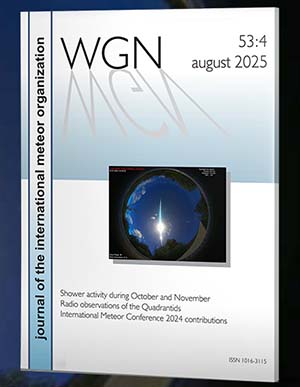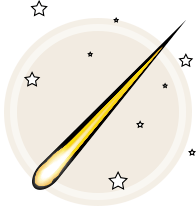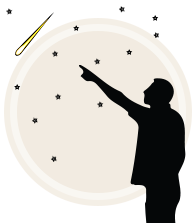The 2000 return of this shower was eagerly awaited because an enhanced
activity was expected. Indeed, the rates were significantly higher than
the average. The last reported Ursid activity enhancement occurred on
Dec. 22, 1996 at solar long. 270.7 with ZHR of the order of 30.
In 2000 the conditions were good as the Moon was almost new. The long
northern nights allow a good overlap. Unfortunately, this first summary
indicates that the most interesting period is not well covered. Most
European observers had to finish around 6h UT (morning twilight). The
number of North American data is scarce so far. As a consequence, we
cannot yet achieve a good profile. Below find the preliminary data.
The high ZHR at the end agrees with Japanese data published here before,
although the errors are still quite large.
------------------------------------------------------- Date Time (UT) Sollong nObs nIND nURS ZHR +/- ------------------------------------------------------- Dec 22 0240 270.553 5 4 16 5.1 1.2 22 0330 270.586 12 9 46 8.2 1.2 22 0410 270.620 16 9 76 12.7 1.5 22 0510 270.658 16 10 104 19.6 1.9 22 0535 270.676 8 6 58 26.1 3.4 22 0935 270.847 2 2 29 53 10 -------------------------------------------------------
Solar longitudes refer to equinox J2000.0. nObs is the number of
individual observing periods, nIND is the number of individual
observers providing them, nURS is the number of Ursids seen. The
population index used was r=2.5. The expectation value of the ZHR,
ZHR = (1 + sum nURS) / sum(Teff/C),
was used for the averages here, where Teff is the effective observing
time and C is the total correction composed of limiting magnitude,
clouds, and zenith correction [sin (h_R)]. Times are rounded to the
nearest 10 minutes.
We are very grateful to the following 15 observers who sent in their reports
in time for this first activity overview:
ARLRA Rainer Arlt (Germany),
BADPI Pierre Bader (Germany),
BUCAN Andreas Buchmann (Switzerland),
CANED Ed Cannon (USA),
ENZFR Frank Enzlein (Germany),
HOSDA Dave Hostetter (USA),
LANMA Marco Langbroek (Netherlands),
LUNRO Robert Lunsford (USA),
LUTHA Hartwig Luthen (Germany),
MOLSI Sirko Molau (Germany),
OSAKA Kazuhiro Osada (Japan),
PUNNI Nilesh Puntambekar (India),
RENJU Jurgen Rendtel (Germany),
STOEN Enrico Stomeo (Italy) and
ZHUJI Jin Zhu (China).




 You saw something bright and fast? Like a huge shooting star? Report it: it may be a fireball.
You saw something bright and fast? Like a huge shooting star? Report it: it may be a fireball.  You counted meteors last night? Share your results with us!
You counted meteors last night? Share your results with us!  You took a photo of a meteor or fireball? You have a screenshot of your cam? Share it with us!
You took a photo of a meteor or fireball? You have a screenshot of your cam? Share it with us!  You caught a meteor or fireball on video? Share your video with us!
You caught a meteor or fireball on video? Share your video with us!